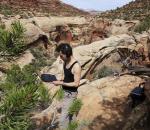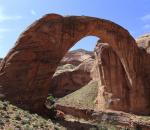
LEFT Custom-built speaker near windows on the first floor of Fairchild Physical Sciences Center. Photo by Rob Strong.

Transmission: a signal that is broadcast or sent out. Or something that is passed on.



LEFT Photos courtesy of Jacob Kirkegaard.

ABOVE Photo courtesy of Jacob Kirkegaard.
Transmission consists of seismic vibration recordings of the ambient resonance of rock arches from around Native American Tribal lands in Utah and Arizona, combined with above-ground acoustic recordings from the same places. These recordings are played back in the atrium of the Physical Sciences Center, with the subterranean sounds on the first floor, and the surface recordings on the fourth. The deep but subtle seismic vibrations from the arches resonate from the bottom of the atrium and occasionally resound in the otherwise quiet space. The above-ground ambient acoustic recordings, made from the areas around the arches, whisper from the top of the tall atrium. This creates a vertical sonic space inside the building spanning from below to above the surface of the earth.
Some of the arches are sacred sites for Native Americans who inhabit the region. One of these—in English known as Rainbow Bridge, or in Navajo as Nonnezoshe, meaning “rainbow turned to stone”—is set in a deep, remote canyon at the foot of Navajo Mountain. Cultures for whom this arch is sacred, and who have visited or used this site for thousands of years, as confirmed by oral testimony, archaeological site analysis, and ethnographic documentation, include the Navajo, Hopi, Kaibab Paiute, San Juan Southern Paiute, White Mesa Ute, and Zuni.
Whereas our surroundings above the earth’s surface mostly relate to the present, archaeologists and geologists utilize the spaces beneath our feet to study the past. Combining these above- and below-ground spaces can be experienced as deep time listening—in the present. Our geological spaces are dark, dense, and slow. They contain, hide, or reveal past events—long forgotten, unknown, or ignored parts of our lives and history. But the obscured past can also be found in the human subconscious, reflecting Native American anthropomorphism of natural features—in particular Rainbow Bridge.
—Jacob Kirkegaard
The seismic vibration data used in Transmission was recorded by geoscientist Jeffrey Moore and geophysics graduate student Paul Geimer from the Department of Geology and Geophysics at the University of Utah. In April 2017, Kirkegaard traveled with Moore and Geimer through Utah and Arizona, gathering seismic data and acoustic recordings.
Jacob Kirkegaard (born 1975) is a Danish artist and composer who works in carefully selected environments to generate recordings that are used in compositions, or combined with video imagery in visual, spatial installations. His works reveal unheard sonic phenomena and present listening as a means of experiencing the world. Kirkegaard has recorded sonic environments as different as subterranean geyser vibrations, empty rooms in Chernobyl, calving Arctic glaciers, and tones generated by the human inner ear. Kirkegaard has presented his works at galleries, museums, and concert spaces throughout the world, including the Museum of Modern Art, New York; the Louisiana Museum of Modern Art and ARoS in Denmark; KW, Berlin; the Menil Collection and the Rothko Chapel in Houston, Texas; and the Mori Art Museum, Tokyo.
Thanks to Jeffrey Moore, Paul Geimer, and Erik Stanfield.

Amelia Kahl is the associate curator of academic programming at the Hood Museum of Art. She runs the museum’s Bernstein Center for Object Study and teaches with the museum’s 65,000-object collection across the Dartmouth curriculum. Her exhibition projects for the Hood have included "Water Ways: Tension and Flow" (2015), "The Stahl Collection" (2015, co-curated with Barbara MacAdam, Jonathan L. Cohen Curator of American Art), and "Emmet Gowin Dreams of Stars" (2014).

Spencer Topel creates installations and performance pieces that are immersive experiences, fusing sound, visual components, and interactive expression. Trained in music conservatories as a composer and violinist, he produced work for orchestral and chamber ensembles for over twenty years. In 2011 he collaborated with sculptor Soo Sunny Park on a yearlong installation titled Capturing Resonance, presented at deCordova Sculpture Park and Museum in Lincoln, Massachusetts. Since then, Topel’s practice has expanded to include visual art in a distinctive body of work that engages artwork as observer and listener, where installations gain agency in the interactions between visitors and environments.
